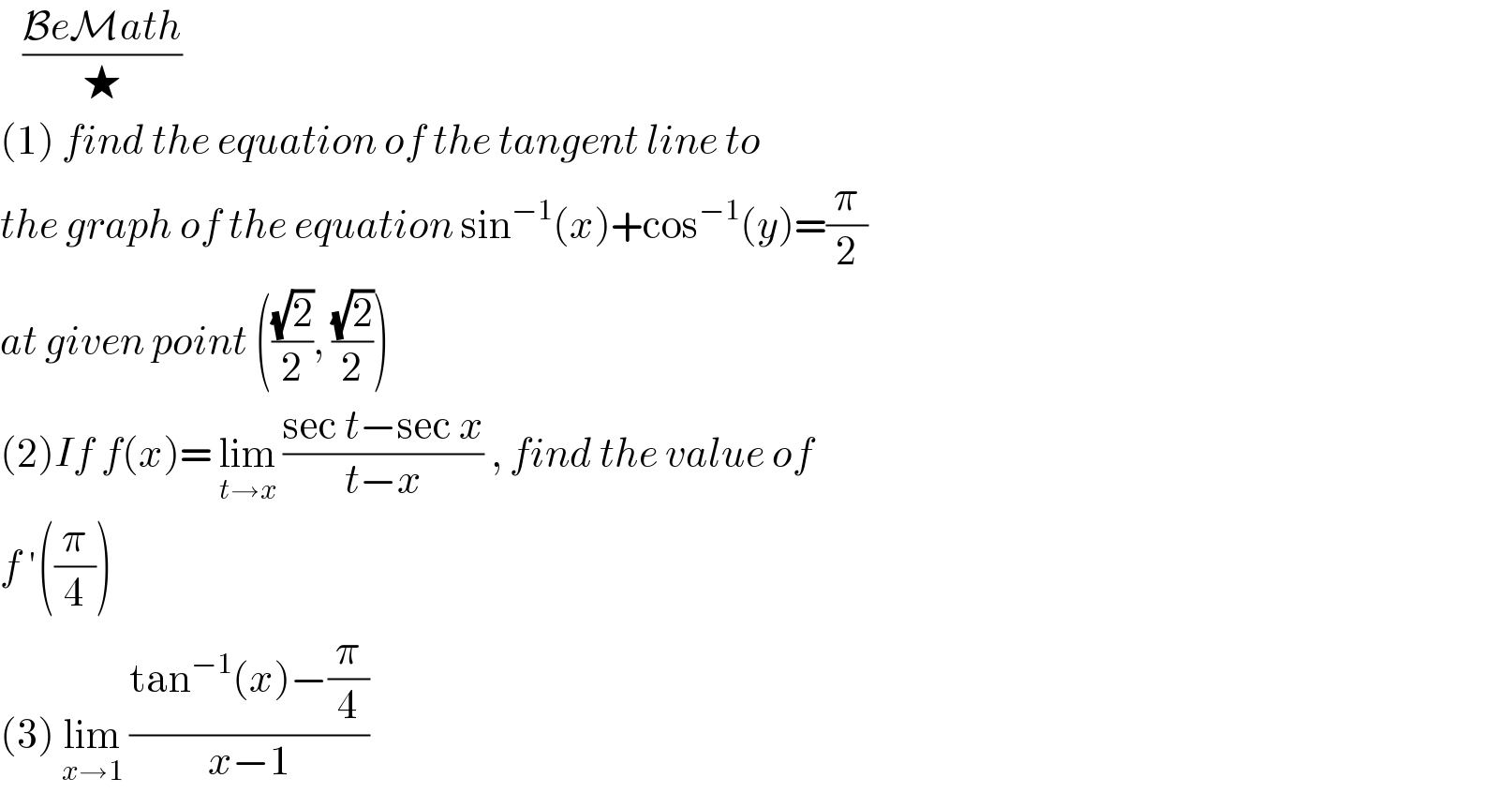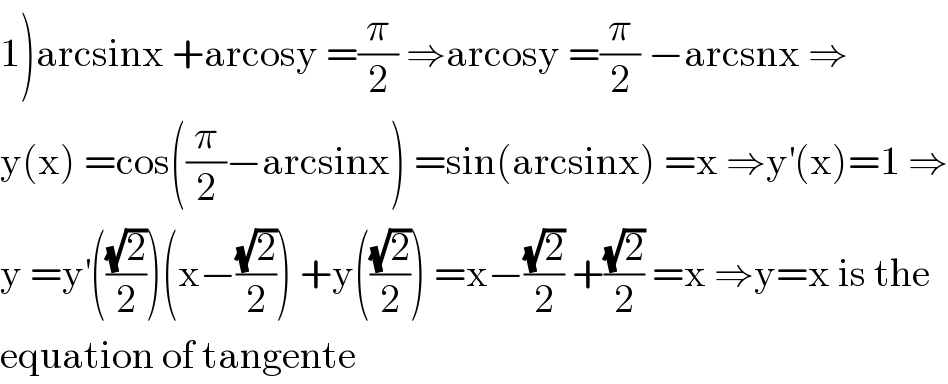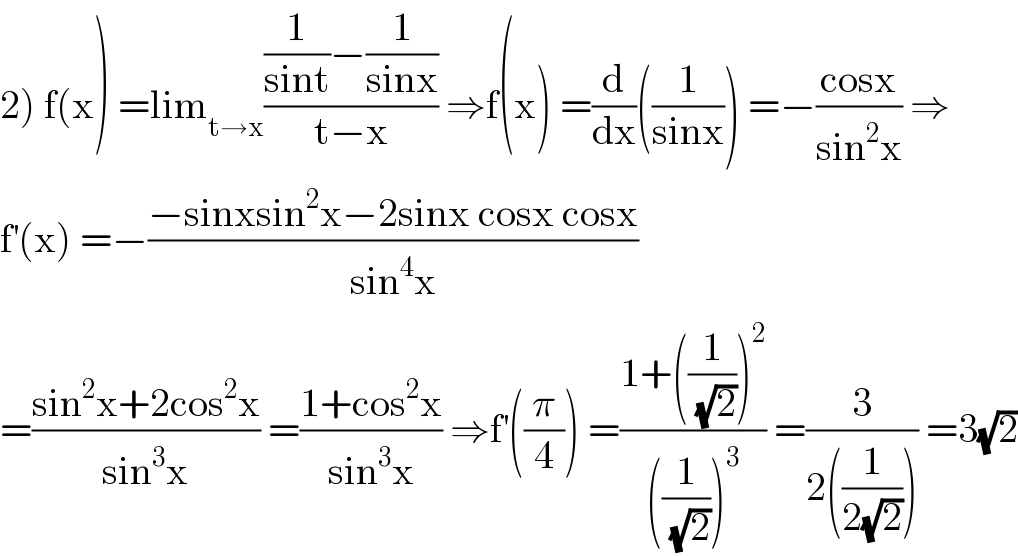
Question Number 108766 by bemath last updated on 19/Aug/20

$$\:\:\:\frac{\mathcal{B}{e}\mathcal{M}{ath}}{\bigstar} \\ $$$$\left(\mathrm{1}\right)\:{find}\:{the}\:{equation}\:{of}\:{the}\:{tangent}\:{line}\:{to} \\ $$$${the}\:{graph}\:{of}\:{the}\:{equation}\:\mathrm{sin}^{−\mathrm{1}} \left({x}\right)+\mathrm{cos}^{−\mathrm{1}} \left({y}\right)=\frac{\pi}{\mathrm{2}} \\ $$$${at}\:{given}\:{point}\:\left(\frac{\sqrt{\mathrm{2}}}{\mathrm{2}},\:\frac{\sqrt{\mathrm{2}}}{\mathrm{2}}\right) \\ $$$$\left(\mathrm{2}\right){If}\:{f}\left({x}\right)=\:\underset{{t}\rightarrow{x}} {\mathrm{lim}}\:\frac{\mathrm{sec}\:{t}−\mathrm{sec}\:{x}}{{t}−{x}}\:,\:{find}\:{the}\:{value}\:{of}\: \\ $$$${f}\:'\left(\frac{\pi}{\mathrm{4}}\right) \\ $$$$\left(\mathrm{3}\right)\:\underset{{x}\rightarrow\mathrm{1}} {\mathrm{lim}}\:\frac{\mathrm{tan}^{−\mathrm{1}} \left({x}\right)−\frac{\pi}{\mathrm{4}}}{{x}−\mathrm{1}} \\ $$
Answered by Dwaipayan Shikari last updated on 19/Aug/20

$$\left.\mathrm{3}\right)\underset{{x}\rightarrow\mathrm{1}} {\mathrm{lim}}\frac{{tan}^{−\mathrm{1}} \frac{{x}−\mathrm{1}}{\mathrm{1}+{x}}}{{x}−\mathrm{1}}=\frac{{x}−\mathrm{1}}{{x}−\mathrm{1}}.\frac{\mathrm{1}}{\mathrm{1}+{x}}=\frac{\mathrm{1}}{\mathrm{2}} \\ $$
Answered by john santu last updated on 19/Aug/20
![((⊸JS⊸)/♥) (1) (d/dx) [ sin^(−1) (x)+cos^(−1) (y) ] = 0 ⇒(1/( (√(1−x^2 )))) −(1/( (√(1−y^2 )))) y′(x) = 0 gradient ⇒y′(((√2)/2)) = ((√(1−(1/2)))/( (√(1−(1/2))))) = 1 ∴ the equation of tangent line y = 1.(x−((√2)/2))+((√2)/2) ; y = x (2)f(x) = lim_(t→x) ((sec t−sec x)/(t−x)) ⇒f(x) = lim_(t→x) ((cos x−cos t)/(cos t.cos x (t−x))) ⇒f(x) = lim_(t→x) (1/(cos t.cos x)) . lim_(t→x) ((−2sin (((x+t)/2))sin (((x−t)/2)))/(t−x)) ⇒f(x) = ((sin x)/(cos^2 x)) →f ′(x) = ((cos^3 x+2sin^2 x cos x)/(cos^4 x)) ⇒f ′(x) = ((cos^2 x+2sin^2 x)/(cos^3 x)) therefore f ′((π/4)) = (((1/2)+2.(1/2))/(1/(2(√2)))) = (3/2). 2(√2) = 3(√2) (3) lim_(x→1) ((tan^(−1) (x)−(π/4))/(x−1)) = lim_(x→1) [ (1/(1+x^2 )) ] =(1/2)](Q108767.png)
$$\:\:\:\:\frac{\multimap{JS}\multimap}{\heartsuit} \\ $$$$\left(\mathrm{1}\right)\:\frac{{d}}{{dx}}\:\left[\:\mathrm{sin}^{−\mathrm{1}} \left({x}\right)+\mathrm{cos}^{−\mathrm{1}} \left({y}\right)\:\right]\:=\:\mathrm{0} \\ $$$$\Rightarrow\frac{\mathrm{1}}{\:\sqrt{\mathrm{1}−{x}^{\mathrm{2}} }}\:−\frac{\mathrm{1}}{\:\sqrt{\mathrm{1}−{y}^{\mathrm{2}} }}\:{y}'\left({x}\right)\:=\:\mathrm{0} \\ $$$${gradient}\:\Rightarrow{y}'\left(\frac{\sqrt{\mathrm{2}}}{\mathrm{2}}\right)\:=\:\frac{\sqrt{\mathrm{1}−\frac{\mathrm{1}}{\mathrm{2}}}}{\:\sqrt{\mathrm{1}−\frac{\mathrm{1}}{\mathrm{2}}}}\:=\:\mathrm{1} \\ $$$$\therefore\:{the}\:{equation}\:{of}\:{tangent}\:{line}\: \\ $$$$\:{y}\:=\:\mathrm{1}.\left({x}−\frac{\sqrt{\mathrm{2}}}{\mathrm{2}}\right)+\frac{\sqrt{\mathrm{2}}}{\mathrm{2}}\:;\:{y}\:=\:{x}\: \\ $$$$\left(\mathrm{2}\right){f}\left({x}\right)\:=\:\underset{{t}\rightarrow{x}} {\mathrm{lim}}\:\frac{\mathrm{sec}\:{t}−\mathrm{sec}\:{x}}{{t}−{x}} \\ $$$$\Rightarrow{f}\left({x}\right)\:=\:\underset{{t}\rightarrow{x}} {\mathrm{lim}}\:\frac{\mathrm{cos}\:{x}−\mathrm{cos}\:{t}}{\mathrm{cos}\:{t}.\mathrm{cos}\:{x}\:\left({t}−{x}\right)} \\ $$$$\Rightarrow{f}\left({x}\right)\:=\:\underset{{t}\rightarrow{x}} {\mathrm{lim}}\:\frac{\mathrm{1}}{\mathrm{cos}\:{t}.\mathrm{cos}\:{x}}\:.\:\underset{{t}\rightarrow{x}} {\mathrm{lim}}\:\frac{−\mathrm{2sin}\:\left(\frac{{x}+{t}}{\mathrm{2}}\right)\mathrm{sin}\:\left(\frac{{x}−{t}}{\mathrm{2}}\right)}{{t}−{x}} \\ $$$$\Rightarrow{f}\left({x}\right)\:=\:\frac{\mathrm{sin}\:{x}}{\mathrm{cos}\:^{\mathrm{2}} {x}}\:\rightarrow{f}\:'\left({x}\right)\:=\:\frac{\mathrm{cos}\:^{\mathrm{3}} {x}+\mathrm{2sin}\:^{\mathrm{2}} {x}\:\mathrm{cos}\:{x}}{\mathrm{cos}\:^{\mathrm{4}} {x}} \\ $$$$\Rightarrow{f}\:'\left({x}\right)\:=\:\frac{\mathrm{cos}\:^{\mathrm{2}} {x}+\mathrm{2sin}\:^{\mathrm{2}} {x}}{\mathrm{cos}\:^{\mathrm{3}} {x}} \\ $$$${therefore}\:{f}\:'\left(\frac{\pi}{\mathrm{4}}\right)\:=\:\frac{\frac{\mathrm{1}}{\mathrm{2}}+\mathrm{2}.\frac{\mathrm{1}}{\mathrm{2}}}{\frac{\mathrm{1}}{\mathrm{2}\sqrt{\mathrm{2}}}}\:=\:\frac{\mathrm{3}}{\mathrm{2}}.\:\mathrm{2}\sqrt{\mathrm{2}}\:=\:\mathrm{3}\sqrt{\mathrm{2}}\: \\ $$$$\left(\mathrm{3}\right)\:\underset{{x}\rightarrow\mathrm{1}} {\mathrm{lim}}\:\frac{\mathrm{tan}^{−\mathrm{1}} \left({x}\right)−\frac{\pi}{\mathrm{4}}}{{x}−\mathrm{1}}\:=\:\underset{{x}\rightarrow\mathrm{1}} {\mathrm{lim}}\:\left[\:\frac{\mathrm{1}}{\mathrm{1}+{x}^{\mathrm{2}} }\:\right]\:=\frac{\mathrm{1}}{\mathrm{2}} \\ $$
Commented by bemath last updated on 19/Aug/20

$${nice}... \\ $$
Answered by mathmax by abdo last updated on 19/Aug/20

$$\left.\mathrm{1}\right)\mathrm{arcsinx}\:+\mathrm{arcosy}\:=\frac{\pi}{\mathrm{2}}\:\Rightarrow\mathrm{arcosy}\:=\frac{\pi}{\mathrm{2}}\:−\mathrm{arcsnx}\:\Rightarrow \\ $$$$\mathrm{y}\left(\mathrm{x}\right)\:=\mathrm{cos}\left(\frac{\pi}{\mathrm{2}}−\mathrm{arcsinx}\right)\:=\mathrm{sin}\left(\mathrm{arcsinx}\right)\:=\mathrm{x}\:\Rightarrow\mathrm{y}^{'} \left(\mathrm{x}\right)=\mathrm{1}\:\Rightarrow \\ $$$$\mathrm{y}\:=\mathrm{y}^{'} \left(\frac{\sqrt{\mathrm{2}}}{\mathrm{2}}\right)\left(\mathrm{x}−\frac{\sqrt{\mathrm{2}}}{\mathrm{2}}\right)\:+\mathrm{y}\left(\frac{\sqrt{\mathrm{2}}}{\mathrm{2}}\right)\:=\mathrm{x}−\frac{\sqrt{\mathrm{2}}}{\mathrm{2}}\:+\frac{\sqrt{\mathrm{2}}}{\mathrm{2}}\:=\mathrm{x}\:\Rightarrow\mathrm{y}=\mathrm{x}\:\mathrm{is}\:\mathrm{the} \\ $$$$\mathrm{equation}\:\mathrm{of}\:\mathrm{tangente} \\ $$
Answered by mathmax by abdo last updated on 19/Aug/20

$$\left.\mathrm{2}\right)\:\mathrm{f}\left(\mathrm{x}\right)\:=\mathrm{lim}_{\mathrm{t}\rightarrow\mathrm{x}} \frac{\frac{\mathrm{1}}{\mathrm{sint}}−\frac{\mathrm{1}}{\mathrm{sinx}}}{\mathrm{t}−\mathrm{x}}\:\Rightarrow\mathrm{f}\left(\mathrm{x}\right)\:=\frac{\mathrm{d}}{\mathrm{dx}}\left(\frac{\mathrm{1}}{\mathrm{sinx}}\right)\:=−\frac{\mathrm{cosx}}{\mathrm{sin}^{\mathrm{2}} \mathrm{x}}\:\Rightarrow \\ $$$$\mathrm{f}^{'} \left(\mathrm{x}\right)\:=−\frac{−\mathrm{sinxsin}^{\mathrm{2}} \mathrm{x}−\mathrm{2sinx}\:\mathrm{cosx}\:\mathrm{cosx}}{\mathrm{sin}^{\mathrm{4}} \mathrm{x}} \\ $$$$=\frac{\mathrm{sin}^{\mathrm{2}} \mathrm{x}+\mathrm{2cos}^{\mathrm{2}} \mathrm{x}}{\mathrm{sin}^{\mathrm{3}} \mathrm{x}}\:=\frac{\mathrm{1}+\mathrm{cos}^{\mathrm{2}} \mathrm{x}}{\mathrm{sin}^{\mathrm{3}} \mathrm{x}}\:\Rightarrow\mathrm{f}^{'} \left(\frac{\pi}{\mathrm{4}}\right)\:=\frac{\mathrm{1}+\left(\frac{\mathrm{1}}{\sqrt{\mathrm{2}}}\right)^{\mathrm{2}} }{\left(\frac{\mathrm{1}}{\sqrt{\mathrm{2}}}\right)^{\mathrm{3}} }\:=\frac{\mathrm{3}}{\mathrm{2}\left(\frac{\mathrm{1}}{\mathrm{2}\sqrt{\mathrm{2}}}\right)}\:=\mathrm{3}\sqrt{\mathrm{2}} \\ $$
Answered by mathmax by abdo last updated on 19/Aug/20

$$\left.\mathrm{3}\right)\:\mathrm{lim}_{\mathrm{x}\rightarrow\mathrm{1}} \:\frac{\mathrm{arctanx}\:−\frac{\pi}{\mathrm{4}}}{\mathrm{x}−\mathrm{1}}\:=\mathrm{lim}_{\mathrm{x}\rightarrow\mathrm{1}} \frac{\mathrm{arctan}\left(\mathrm{x}\right)−\mathrm{arctan}\left(\mathrm{1}\right)}{\mathrm{x}−\mathrm{1}} \\ $$$$=\mathrm{arctan}^{'} \left(\mathrm{1}\right)\:=\frac{\mathrm{1}}{\mathrm{2}} \\ $$
